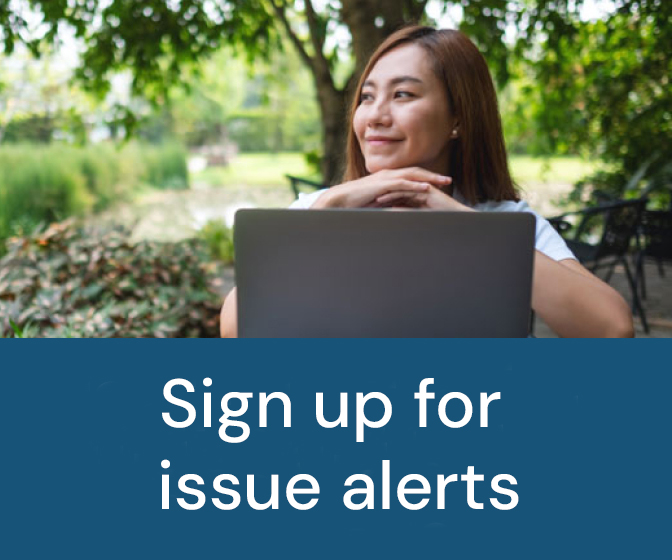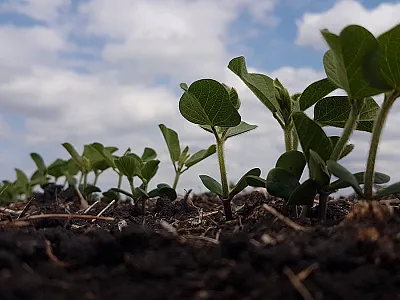Forage crop irrigation with wastewater: Understanding the exposure risk


A dairy cow can eat more than 100 pounds of food a day, and whatever’s in that feed can make its way into the milk, yogurt, cheese, and ice cream that we enjoy. This includes per- and polyfluoroalkyl substances (PFAS), the “forever chemicals” that were widely used in consumer products and industrial processes for decades.
This month, we’ll look at two new studies probing how reused waste contributes to PFAS exposure in the environment, both published as part of the new Journal of Environmental Quality (JEQ) special section, “PFAS in Agroecosytems: Sources, Impacts, and Opportunities for Mitigating Risks to Human and Ecological Health.”
In this article, researchers tested how PFAS accumulate in corn and grass that is spray-irrigated with reused wastewater.
Earn 0.5 CEUs in Soil & Water Management by reading this article and Earn 0.5 CEUs in Soil & Water Management by reading this article and taking the quiz.
A dairy cow can eat more than 100 pounds of food a day. A lot, sure, but it’s hard work making the nutrient-rich milk we mix into our coffee or transform into yogurt, cheese, and ice cream.
Whatever’s in that feed can make its way into that milk, including per- and polyfluoroalkyl substances (PFAS), the “forever chemicals” that were widely used in consumer products and industrial processes for decades. Because of their ubiquity, PFAS have been detected broadly across the environment, including in the wastewater treatment plants that process our sewage.
This presents a conundrum for those who want to reuse that refuse in an environmentally friendly way says Heather Preisendanz, a researcher at Pennsylvania State University and an SSSA member. “There’s a lot of beneficial reasons that we … reuse wastewater,” she says: it eases the depletion of freshwater resources and reduces discharge into waterways, to name just two. But using potentially contaminated wastewater to irrigate crops that feed the livestock we get milk and meat from is an obvious concern. “If there are PFAS getting into the feed, then there’s the potential for those PFAS compounds to transfer into either what would become meat products or what would become dairy products,” Preisendanz says.
This month, we’ll look at two new studies probing how reused waste contributes to PFAS exposure in the environment, both published as part of the new Journal of Environmental Quality (JEQ) special section, “PFAS in Agroecosytems: Sources, Impacts, and Opportunities for Mitigating Risks to Human and Ecological Health.” In their paper “From Wastewater to Feed: Understanding Per- and Polyfluoralkyl substances occurrence in Wastewater-Irrigated Crops,” Preisendanz and co-authors Kelly Kosiarski and Charles (Zeke) Usner tested how PFAS accumulate in corn and grass that is spray-irrigated with reused wastewater. They found that the practice isn’t a likely contributor to PFAS concentrations in these forage crops.

“If we agree that beneficial wastewater use is a good thing to do, which I think we generally agree that it is, then there doesn't seem to be an increased risk for using the spray irrigation,” says Preisendanz, lead editor on the special section.
Molecule chains and food chains
Beneficial wastewater reuse comprises a small portion of agricultural irrigation. In 2018, about 1.5 million total acres of cropland in the U.S. were irrigated with recycled and reclaimed water, according to data from the USDA National Agricultural Statistics Service 2018 Irrigation and Water Management Survey. The practice varies state by state with Arkansas, California, Connecticut, Massachusetts, North Carolina, Ohio, and Wisconsin all topping the list and watering at least 3% of their irrigated acreage with reused water.

Typical wastewater treatment plants will rely on biodegradation by microorganisms to break down organic substances in influent. But the PFAS seen in wastewater typically already are the final degradation by-products, Preisendanz says. And sometimes, the PFAS that end up in effluent is actually the degradation by-product of other compounds coming in with the influent. “You’ll see sometimes higher concentrations of these PFAS compounds in the effluent than in the influent because precursors have broken down,” she says.
Removal of PFAS at wastewater treatment plants isn’t common. When investing in expensive technologies, engineers at these facilities want to have some assurance they’d be able to get down to goal levels, Preisendanz says. However, the USEPA has not yet published regulations for PFAS in wastewater effluent and just issued a method for testing for the substances in January 2024. “I think there’s interest in responding to policies if and when they get implemented,” Preisendanz says.
Techniques like activated carbon and reverse osmosis can remove them, but those are more commonly used in drinking water systems. Different PFAS compounds can have different carbon chain lengths, and those processes are typically more effective for longer- than shorter-chain PFAS. “We typically see the shorter-chain compounds persist in the wastewater, whereas the longer chains are more typically found in the biosolids of the solid phase of the water treatment process,” explains Kosiarski, a graduate student at Penn State and the lead author of the new study.

But Preisendanz notes that researchers still see two of the most common PFAS out there, the long-chained PFOS and PFOA, in wastewater despite being phased out of products in the early 2000s. These compounds have been linked to more serious health problems and tend to bioaccumulate, or build up in organisms ascending the food chain, more than shorter-chain ones. “The short-chain compounds are excreted much quicker from mammals,” Kosiarski says. “That’s why they’re typically regarded as less bioaccumulative and less toxic because they don’t persist in our tissues as long as the long chains do.”
Forage and the living filter
Preisendanz has been studying PFAS at Penn State since 2019. For over 50 years, the university has operated a beneficial reuse facility site on campus known as the Living Filter; 600 acres of farmland and forest irrigated with treated wastewater from the Happy Valley campus. Livestock raised on campus eat crops grown on fields at the Living Filter site.
Penn State has a permit through the Pennsylvania Department of Environmental Protection to carry out this irrigation, which stipulates that it must submit regular samples from across the site’s 13 monitoring wells to ensure it’s compliant with state drinking water standards for nitrate (though the wells are not actually used as potable water sources). So when conversations about PFAS levels in drinking water regulations began heating up, the university asked Preisendanz’s lab to add PFAS to the suite of contaminants being monitored in these wells. (The state of Pennsylvania published its own PFAS drinking water standards in January 2023.)
“They were really proactive in trying to understand what their exposure was at the facility,” Preisendanz says. “I was really encouraged by that.” Her lab obtained grant funding to monitor the wells through 2023 and began amassing four years’ worth of influent, effluent, crop, and soil data. In a previous study in JEQ, Preisendanz and colleagues detected PFAS in tissue from crops grown in fields at the Living Filter site. But the researchers were curious about the PFAS risk from the irrigation water directly. “Some of the questions that came up from the data from the field site were around the potential increase for PFAS to be getting into the crop tissue from the spray irrigation itself,” Preisendanz says.

The team set up the present study, which Kosiarski completed for her master’s degree, in the greenhouse, so they could isolate the different possible uptake pathways—through the roots versus through the leaves—of PFAS into the plant. They planted corn and orchard grass in either Living Filter soil or control soil, watered the crops with either treated wastewater effluent or control tap water, and/or spray-irrigated them with the wastewater. Kosiarski then harvested the plants and analyzed them, as well as the soils and leachate, for PFAS.
Compared with the controls, the crops spray-irrigated with wastewater didn’t show a noteworthy amount of PFAS uptake. The results suggested that PFAS is more likely taken up through the crops’ roots rather than via the irrigation water sprayed directly onto the crops’ leaves. And overall, PFAS exposure didn’t affect the health and yield of the plants. “There doesn't seem to be an increased risk for using the spray irrigation,” Preisendanz says.
The team did detect PFAS more frequently in the grass than in the corn with the majority being the shorter-chain compounds. Why might corn not uptake more readily? Kosiarski has some ideas. “There’s a difference in root structure,” she says. “Corn has a very thick taproot in the center and a lot of huge, fibrous roots, whereas grass tends to have smaller, more fine roots.”

This creates a larger overall total surface area, which could lead to increased uptake. Additionally, corn roots can reach quite deep into the soil while PFAS compounds absorb near the soil surface, the researchers say.
The researchers then used the data to estimate how much PFAS would be in livestock feed made from the sampled corn and grass. “We have the recipe for what the cattle raised on campus are eating,” Preisendanz says. From there, they used the PFAS concentrations they measured in the crop tissues to calculate PFAS load to cattle consuming it. They found that based on these estimations, feed produced from many of their samples would exceed weekly PFAS intake standards set by the European Food Safety Authority.
These calculations are preliminary, and more research on PFAS effects in cattle is needed, the researchers say. They haven’t yet been able to study PFAS bioaccumulation in actual animals, but they made the projections “to provide some perspective on what the numbers could be,” Preisendanz says. “That way they’re out in the literature and other people who do have that area of expertise could take those numbers and help interpret what that meant.”
The bigger picture
Preisendanz’s lab continues to investigate the PFAS issue from many angles. They’re studying how farmers who do have elevated PFAS levels in their soil can safely grow crops, looking at remediation and crop choice. They’ve also just received funding from the state of Pennsylvania to study hemp’s potential as a phytoaccumulator of the chemicals. And they’re looking at PFAS concentrations in private wells across the state, building a database and tool that would help users understand their risk.
Public awareness and outreach are priorities for Preisendanz and many others studying this issue, especially when working with producers who want to understand the PFAS risk on their own land and/or with the systems they use to irrigate and fertilize it. “The need feels very urgent,” Preisendanz says. “Having worked in emerging contaminants for the past 15 years or so now, I’ve never seen a topic quite this widespread and in everybody’s news feed quite the way this one is.”
Overall, the research published in the JEQ special section can be used to guide further collaborations investigating the issue and future decisions intended to protect human and ecological health. “We need big teams that are collaborating to work on this problem,” Preisendanz says. “I'm glad to say that those conversations are happening. I feel encouraged by that.”
Dig deeper
Read the study in JEQ here:
Kosiarski, K., Usner, C.(Z)., & Preisendanz, H. E. (2024). From wastewater to feed: Understanding per- and polyfluoroalkyl substances occurrence in wastewater-irrigated crops. Journal of Environmental Quality. https://doi.org/10.1002/jeq2.20630
And check out the special section in JEQ, “PFAS in Agroecosytems: Sources, Impacts, and Opportunities for Mitigating Risks to Human and Ecological Health.”
Self-study CEU quiz
Earn 0.5 CEUs in Soil & Water Management by taking the quiz for the article at https://web.sciencesocieties.org/Learning-Center/Courses. For your convenience, the quiz is printed below. The CEU can be purchased individually, or you can access as part of your Online Classroom Subscription.
The USDA National Agricultural Statistics Service 2018 Irrigation and Water Management Survey found that ____ acres of U.S. cropland were irrigated with recycled and reclaimed water.
a. 1.2 million
b. 1.3 million
c. 1.5 million
d. 3 million
Which of the following is true of shorter-chain PFAS?
a. They tend to bioaccumulate more.
b. They are linked to more serious health problems.
c. They tend to bioaccumulate less.
d. Both a and b.
Typically, wastewater treatment plants do not remove PFAS.
a. True.
b. False.
In a study in JEQ, researchers planted which crops to study PFAS uptake after irrigation with reused wastewater?
a. Corn and perennial ryegrass.
b. Orchardgrass and perennial ryegrass.
c. Corn, perennial ryegrass, and orchardgrass.
d. Corn and orchardgrass.
What did the study results suggest about how PFAS uptake occurs?
a. PFAS are more likely taken up through irrigation water sprayed on crops’ leaves than through roots.
b. PFAS are more likely taken up through crops’ roots than through irrigation water sprayed on leaves.
c. PFAS are more likely taken up in corn than grass.
d. PFAS uptake was equivalent in both roots and leaves.
Text © . The authors. CC BY-NC-ND 4.0. Except where otherwise noted, images are subject to copyright. Any reuse without express permission from the copyright owner is prohibited.










